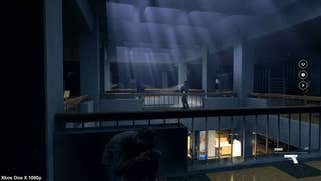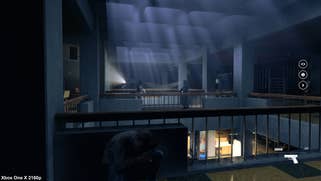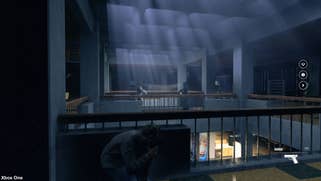Can Xbox One X really run Quantum Break at 4K?
Digital Foundry goes hands-on.
Remedy's Quantum Break was announced for Xbox One X back at Gamescom and we managed to get a few minutes of time on the game, where first impressions were positive. The resolution upgrade was palpable and performance looked relatively solid. A couple of weeks on, and we managed to get a more extended hands-on with the X port of what is undoubtedly one of the generation's most technically challenging games. In some respects, the conversion is even more impressive than we thought, but in others, we hope to see some improvement before the title update releases alongside the console on November 7th.
First of all, it should come as no surprise to anyone familiar with the game that Quantum Break is not running at a native 3840x2160 resolution, as impressive as the upgrade is over the standard console version. So what is it doing then? Well, Quantum Break makes use of a temporal reconstruction technique, where the game uses information from previous frames to create an end result exceeding the quality of native resolution alone. On Xbox One, that base resolution is a lowly 720p. Thanks to its reliance on multi-sampling, the end results are certainly clean, but with so few pixels at its core, the end result is rather blurry.
This same technique was included in the PC version as well, but it eventually became possible to disable it and utilise higher base resolutions. Of course, this places huge demands on PC hardware, owing to the sheer ambition behind the game's renderer. In fact, whether you're using reconstruction or not, it can cause issues for even the most powerful of PC hardware. To illustrate, a Titan Xp GPU - the fastest single-chip graphics card money can buy - running the game at close to max settings can lock to 60fps, but only at a 1440p resolution with reconstruction active.
In moving to Xbox One, the temporal reconstruction technique returns in full force. Essentially, we're looking at a 4x resolution boost here over Xbox One, with a base pixel count of 2560x1440. The reconstruction helps create the illusion that it's running at a higher pixel count, but unlike checkerboard or sparse grid rendering, it lacks both the clarity and sharpness of a 4K image. In this case, however, it does at least play into the visual design of the game, which aims to appear more filmic - that is, emulating the look of a camera rather than a super sharp rendered image.
In addition to the resolution bump - which offers a massive improvement alone, as the shots below should illustrate - texture filtering is also greatly improved, which could be a combination of the increased resolution and a higher level of anisotropic filtering. Either way, textures are much sharper as a result. And it's got to be said that visually, Quantum Break still holds up very well, with highly detailed character models, beautiful volumetric lighting, a nice implementation of global illumination and excellent post-processing effects.
But the fly in the ointment - on the early build we saw, anyway - is performance. Microsoft's target for the Xbox One X spec is all about delivering a 4x to 5x boost to resolution with the same ballpark performance level. Quantum Break targets 30fps but uses adaptive v-sync, introducing screen-tear if it can't hit its render budget. Frames are dropped but it is relatively infrequent - which is not the case with the Xbox One X build we saw, where combat is clearly choppier than the base console, a situation we confirmed once we got back to base and replayed the game.









By and large, the drops are not massive: we're still in the high 20s here, so we hope that a further optimisation push can bring it level with the base Xbox One while retaining the big visual upgrade. The sense we get is that based on the areas of the game we've tested, around 10 per cent of extra overhead is required to get the same kind of consistent performance level seen on the standard Xbox One. That sounds reasonably attainable, but we should point out that we only played the first 35 to 40 minutes of the game, and our concern is about the more challenging areas further on. To put the performance situation into perspective though, the comparison shots on this page suggest that the Xbox One X code is running on higher quality settings than the base version. Lighting is further refined and additional scene geometry is present, for starters.
However, even if the code does not improve, there is another option. Dipping into the settings, we spied a 1920x1080 resolution option, alongside the default 3840x2160. It's curious because the latter doesn't natively resolve true 4K (temporal reconstruction is in effect, after all). However, the former does seem to operate at a native 1080p. We only played this mode for a few moments, but the captures suggest that it's a full 1920x1080 with temporal anti-aliasing, but no reprojection from prior frames. Our emphasis with the limited time available was to grab as much 4K video as we could, but logically, the 1080p mode should offer rock-solid performance. It's rendering just 56 per cent of the 4K mode's base resolution, and no GPU cycles are deployed on reconstruction. Those hoping for an unlocked frame-rate or even 60fps will be disappointed though - the title's standard 30fps cap is in full effect on both modes.
So that's where we're at right now with Quantum Break on Xbox One X. Users are set to enjoy a significant boost to resolution on a title that is massively demanding on all platforms. However, even if you stick with the 1080p mode, the X version of Quantum Break still offers a nice improvement over the original Xbox One version in terms of image quality - there's a 2.25x boost to the base pixel count just for starters. It's much less blurry than before and of course, if you're not so wedded to rock-solid performance, you can supersample down from the 4K output instead - a feature that's standard on all titles on the Xbox One X system. We're really hoping that the tearing and performance drops can be minimised on the final version of the code though: this is a beautiful game that benefits greatly from its 4K support, and a title we're looking forward to playing through again in its latest incarnation.


















